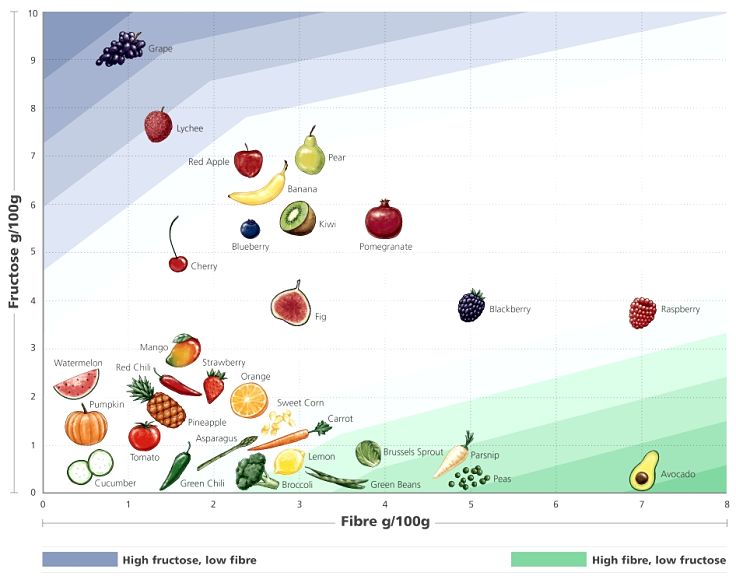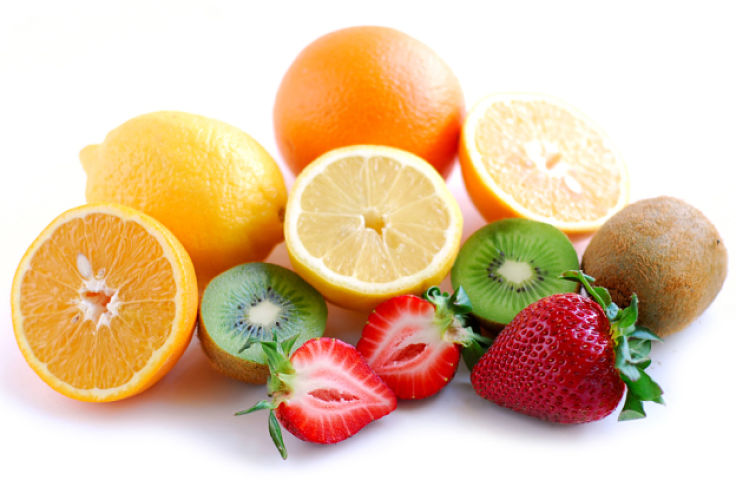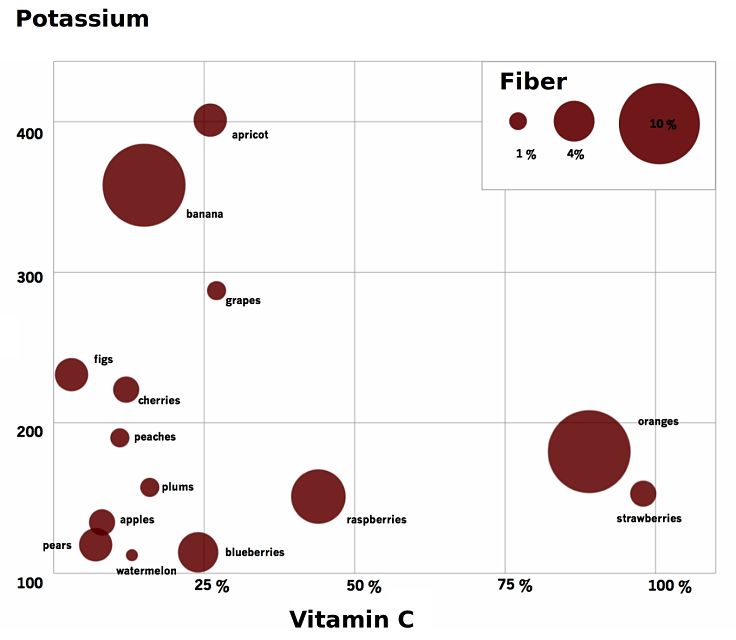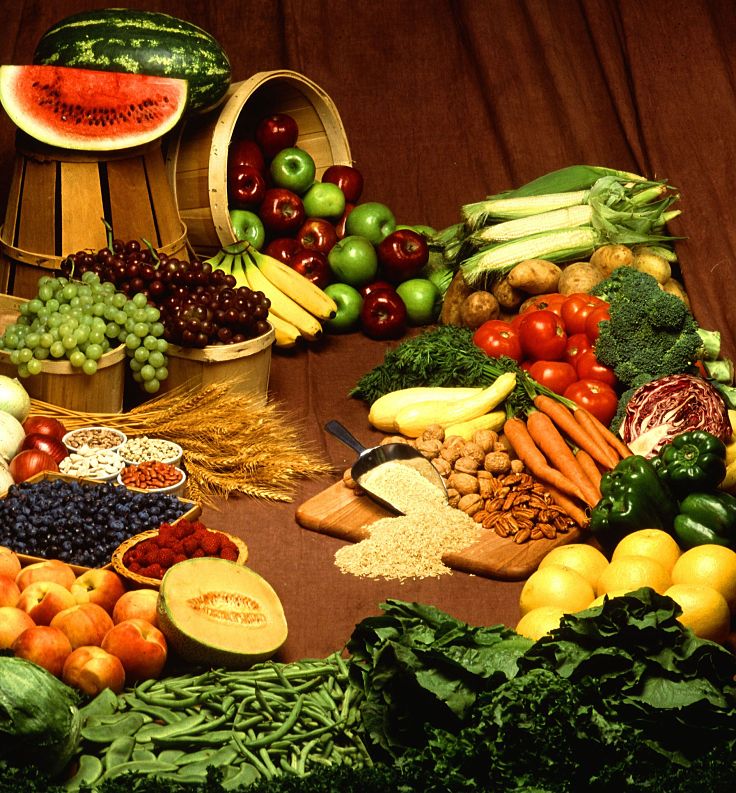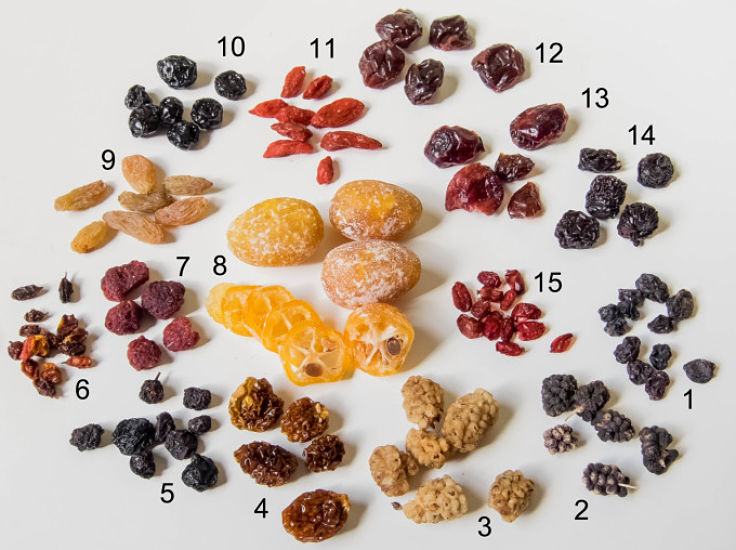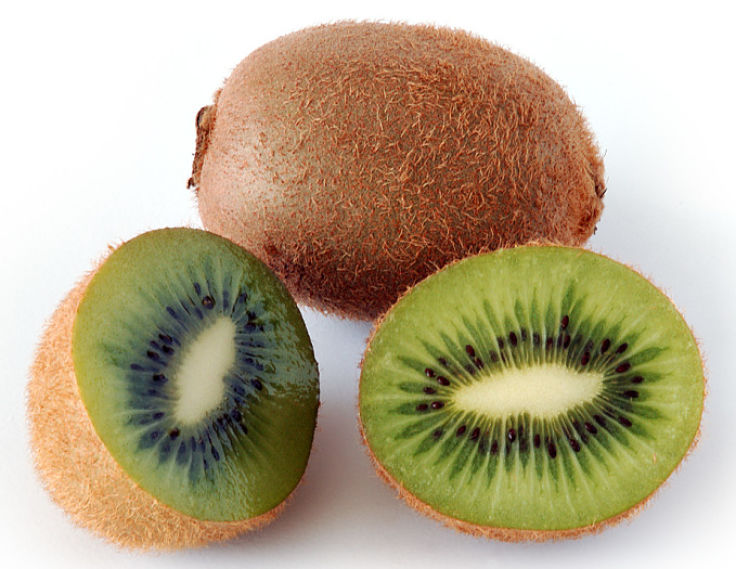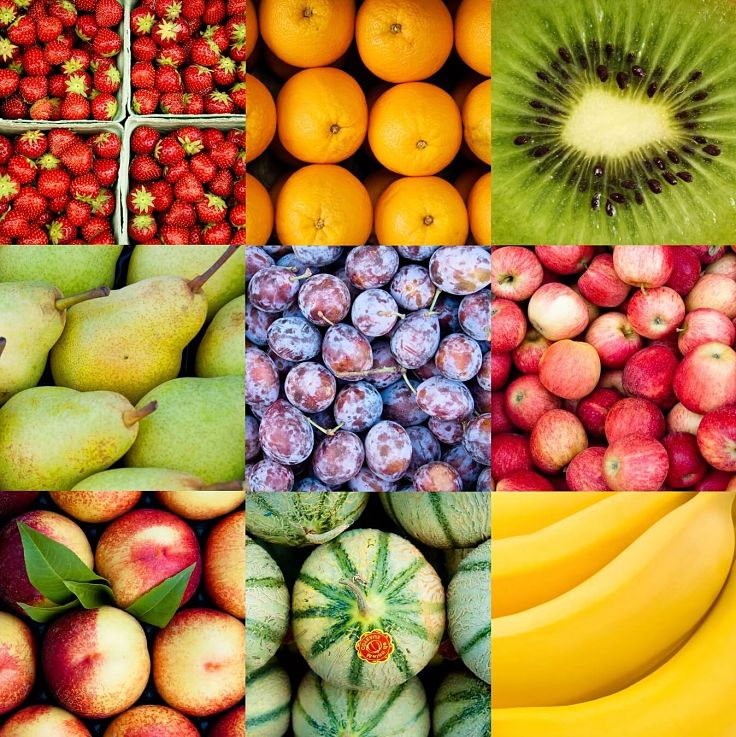What Fruit is Healthiest For Calories, Fiber, Fat, Vitamins, Minerals
Fruits are a natural source of calories, protein, vitamins, fat, minerals, antioxidants, fiber and lots of other goodies. Fruits can be eaten raw as a snack, cooked for main meals, entrees, desserts, blended into smoothies, or juiced and consumed and an extract.
Most dieticians and health organisations recommend that people eat at least 3 cups or three portions of fruit a day, and have some fruit with every meal.
However, not all fruits are created equal in terms of nutrients and healthiness.
So given a wide choice what fruits are the healthiest and how can you determine this?
The answer to this question really depends on what you are looking for - fruits that are low in calories, high protein, low fat, rich in fiber, full of vitamins, rich in minerals and fruits which are good 'all rounders'.
This article is designed to answer these questions and provide comprehensive nutrient information on 100 fruits.
One of the problem with that data that are available for fruits is that the information is normally present as nutrients per serving, but the serving size varies, and so it is hard to make proper comparisons.
This article has solved this problem by presenting that data for nutrients in a standard serving of 100 g.
What is a Fruit?
In scientific terms, a fruit is the part of a flowering plant derived from the ovary of a plant and contains seeds. A fruit is a swollen or ripened ovary, encasing the seeds which are mature ovules.
Fruits can be formed from one carpel, or from many carpels fused together, or from many carpels in a bunch.
The term 'vegetable' normally refers to the leafy green, root, stem or even flower stalk part of an edible plant.
Fruits that are edible, are a seed dispersal mechanism. as the seed get spread when eaten by animals and humans.
Fruits are a major component of the world's agricultural output, and some (such as the appleand the pomegranate) have acquired extensive cultural and symbolic meanings.
Some fruit such as bananas do in fact have seeds, though they are tiny and hard to see.
Various seed-less varieties of fruits have been produced to make them more palatable for humans. But the original species all had seeds
Most other fruits, such as oranges, apples, peaches, pears, avocado, do produce viable seeds.
Why are Fruits Good for You?
Fruits can be regarded as flavoursome containers of carbohydrates, water, fiber, vitamins, minerals and many anti-oxidants and other healthy compounds. They generally have low calorie density because they are mostly water.
For modern Western diets focused primarily on highly processed foods fruits and vegetables are the major source of fiber and nutrients that are lost when whole food are processed. For example white flour and white rice has had the bran removed. The wheat germ found naturally in unprocessed grains is also removed. This germ contains most of the nutrients in wheat. So there is increased reliance on fruit and vegetablesto supply fiber and essential nutrients to keep the body functioning properly.
Some of the key points are:
- Fruits are generally low in fat, except for avocado, durian, horned melon, pomegranate, sapodilla and guava. However people on low fat and low calorie diet should avoid these fruits
- Fruits are low in cholesterol.
- Fruits are generally low in protein, but vegetarians and vegans may choose fruits that have higher protein levels and some essential amino acids that they need to ensure they get enough protein.
- Most fruits have low calories, but the range varies from less than 30 Calories per 100g for melon, lemon, lime and watermelon, to a whopping 148 Calories for durian, 158 for avocado 240 for tamarind and 278 for dates. The GI of fruit also varies greatly depending on whether the carbohydrate is present as sugars which are processed quickly or more resistant forms such as starch.
- Fruits are an excellent source of dietary fiber which is important for a healthy gut and for helping to reduce the risk of cancer. Fiber is also important for adding bulk to food increasing the sense of fullness and delaying hunger pangs. Soluble fiber also encases other food in the stomach and intestine delaying digestion and helping to avoid peaks in blood glucose levels. Fiber levels in fruit also vary considerably from about 10 g per 100 g in passion-fruit, dates and elderberries to only one third of gram in watermelon.
- Fresh fruits are fabulous sources of vitamin C, but again the amount present varies considerable from the high values of 228 mg per 100 g in guava, 181 in currants (black) and 93 in kiwifruit, to values less than 4 mg in 100 g of dates, loquats, figs and tamarind.
- Fresh fruits are also an excellent source of many other Vitamins such as Niacin, Folate, Vitamin A, Vitamin E and Vitamin K. Once again the amount varies greatly between fruits. Vitamin A levels range from high values of 3383 International Units (IU) in 100 g of melon (cantaloupe) , 1926 in apricots and1528 in loquats. Many fruits have very little Vitamin A, with many having less than 10 IU per 100g - soursop, cherimoya, sugar-apple, feijoa
- Fruits are an excellent source of essential minerals such as Calcium, Iron, Magnesium, Phosphorus and Potassium.
The conclusion from this is that fruits are generally good for you but it pays to do your homework to choose fruits that will provide exactly what you are looking for. The tables below that summarize the key nutrients are designed to provide that advice. You can click on the table headings to sort for the various nutrients. many nutrients have been omitted because they are found in low concentrations, though they are nevertheless important (such as the phyto-nutrients associated with the colors of fruits and beta-carotenes).
What is the Healthiest Fruit?
In order to answer this question the nutrients in 100 fruits have been compiled into three tables. Various formulae have been used to combine the nutrients into three Groups:
- Macro Nutrients - Calories, Protein, Total Fat, Total Carbohydrates and Dietary Fiber
- Vitamins - Niacin, Folate, Vitamin C, Vitamin A, Vitamin E and Vitamin K.
- Minerals - Calcium, Iron, Magnesium, Phosphorus and Potassium
Using the values in the table simply formulae have been applied to each of the components above are given an equal weight. So the best fruits for minerals are the best all rounders that have the highest amounts of Calcium, Iron, Magnesium, Phosphorus and Potassium taken together with equal weight in the formula. The same applies for the other groups. For the Macro nutrients Calories, Total Fat and Carbohydrates were included as negatives in the formula.
Below are the best fruits for various criteria and nutrients listed with the highest scoring fruits first, and then in order of decreasing score - the top 25 -35 fruits are shown.
Healthiest Fruit Overall
In this case the best fruit were the ones with the higher macro nutrient scores, Vitamin scores and Mineral scores with equal weight given to the three elements. The top 30 list of best overal fruits is shown below with the highest scoring fruits listed first. Many of these such as kiwi fruit, blackberries and mango have a reputation as 'super-fruit'. Others such as avocado are clearly a compromise because avocado has very high fat levels compared with other fruits, but is rich in nutrients.
Currants (black); tamarind; guava; melon (cantaloupe); passion-fruit; tangerine (mandarin); kiwifruit; apricot; plantain; dates; elderberries; mulberries; avocado; papaya; blackberries; mango; kumquats; loquats; raspberries; breadfruit; loganberries; grapefruit; sugar-apple; jackfruit; orange; pomegranate; strawberries; soursop; custard-apple; gooseberries; horned melon; durian; clementines; lemon; litchis; banana; longans; cherimoya; feijoa; peach; lime; figs; sapodilla; pineapple; plum; pummelo; grapes, red or green; blueberries; watermelon
Macro-Nutrients
Passion-fruit; guava; currants (black); loganberries; blackberries; raspberries; kumquats; feijoa; lemon; sugar-apple; elderberries; carambola (starfruit); cranberries; gooseberries; lime; melon (casaba); pear; Asian; mulberries; apricot; orange; soursop; strawberries; kiwifruit; green; peach
Combined Vitamins
Melon (cantaloupe); guava; currants (black); tangerine (mandarin); apricot; kiwifruit; green; avocado; mango; papaya; passion-fruit; plantain; loquats; grapefruit; blackberries; orange; elderberries; strawberries; kumquats; pomegranate; raspberries; litchis; loganberries; mulberries; clementines
Combined Minerals
Tamarind; dates; currants (black); passion-fruit; mulberries; tangerine (mandarin); elderberries; avocado; plantain; breadfruit; kumquats; custard-apple; durian; horned melon; guava; jackfruit; kiwifruit; green; sugar-apple; soursop; raspberries; blackberries; loganberries; banana; figs
Least Calories
Melon (casaba); lemon; lime; watermelon; carambola (starfruit); strawberries; melon (cantaloupe); melon (honeydew); pummelo; peach; grapefruit; pear; Asian; papaya; blackberries; mulberries; gooseberries; horned melon; cranberries; plum; orange; clementines; loquats; apricot; pineapple
Most Protein
Tamarind; guava; dates; passion-fruit; sugar-apple; avocado; kumquats; horned melon; jackfruit; custard-apple; tangerine (mandarin); pomegranate; cherimoya; loganberries ; durian; mulberries; apricot; blackberries; currants (black); longans; plantain; raspberries; kiwifruit; green; melon (casaba)
Least Total Fat
Pummelo; longans; quinces; melon (casaba); orange; pineapple; pear; grapefruit; melon (honeydew); cranberries; clementines; watermelon; grapes, red or green; apple (with skin); melon (cantaloupe); lime; cherries; sweet; loquats; breadfruit; pear (Asian); peach; papaya; plum; sugar-apple
Least Carbohydrate
Melon (casaba); carambola (starfruit); watermelon; horned melon; strawberries; melon (cantaloupe); avocado; melon (honeydew); lemon; peach; blackberries; pummelo; mulberries; gooseberries; lime; pear; Asian; grapefruit; papaya; apricot; plum; orange; raspberries; clementines; loquats
Most Vitamin C
Guava; currants (black); kiwifruit; green; longans; litchis; pummelo; papaya; strawberries; tangerine (mandarin); orange; lemon; clementines; pineapple; kumquats; melon (cantaloupe); mulberries; sugar-apple; mango; elderberries; carambola (starfruit); feijoa; grapefruit; passion-fruit; lime
Most Vitamin A
Melon (cantaloupe); apricot; loquats; tangerine (mandarin); passion-fruit; grapefruit; plantain; mango; papaya; guava; elderberries; watermelon; plum; peach; gooseberries; kumquats; currants (black); orange; blackberries; horned melon; avocado; figs; jackfruit; kiwifruit
Most Folate
Avocado; guava; mango; pomegranate; papaya; durian; tangerine (mandarin); orange; loganberries ; blackberries; kiwifruit; clementines; jackfruit; feijoa; strawberries; cherimoya; plantain; melon (cantaloupe); raspberries; banana; dates; melon (honeydew); pineapple; kumquats
Most Vitamin K
Kiwifruit; currants (black); avocado; blackberries; blueberries; pomegranate; grapes, red or green; raspberries; loganberries ; mulberries; plum; cranberries; figs; pear (Asian); pear; mango; feijoa; apricot; tamarind; melon (honeydew); dates; peach; guava; papaya
Most Vitamin E
Currants (black); avocado; kiwifruit; cranberries; blackberries; mango; apricot; raspberries; mulberries; loganberries ; peach; guava; pomegranate; blueberries; tangerine (mandarin); gooseberries; jackfruit; papaya; strawberries; cherimoya; plum; lime; clementines; grapes, red or green;
Most Calcium
Tangerine (mandarin); tamarind; kumquats; currants (black); mulberries; orange; dates; elderberries; figs; kiwifruit; lime; custard-apple; clementines; blackberries; raspberries; lemon; loganberries ; gooseberries; jackfruit; sugar-apple; grapefruit; sapodilla; papaya; guava
Most Iron
Tamarind; mulberries; elderberries; passion-fruit; currants (black); horned melon; dates; kumquats; sapodilla; custard-apple; quinces; raspberries; loganberries ; blackberries; lime; lemon; sugar-apple; soursop; plantain; avocado; breadfruit; durian; strawberries; apricot
Most Potassium
Dates; tamarind; plantain; breadfruit; avocado; jackfruit; durian; guava; custard-apple; banana; passion-fruit; tangerine (mandarin); currants (black); persimmon, native; kiwifruit, green; cherimoya; soursop; elderberries; melon (cantaloupe); loquats; longans; apricot; jujube; sugar-apple
Most Phosphorus
Tamarind; passion-fruit; dates; currants (black); avocado; tangerine (mandarin); guava; durian; elderberries; horned melon; mulberries; pomegranate; plantain; kiwifruit, green; sugar-apple; litchis; breadfruit; raspberries; loquats; soursop; gooseberries; cherimoya; loganberries; persimmon, native
Macro Nutrients in 100 g of Various Fruits
(click column header to sort results)| Fruit (Serving 100 g) | Calories (Cal) | Protein (g) | Total Fat (g) | Total Carbohydrates (g) | Dietary Fiber (g) |
|---|---|---|---|---|---|
| apple | 52 | 0.26 | 0.17 | 13.81 | 2.42 |
| apricot | 49 | 1.4 | 0.39 | 11.11 | 2 |
| avocado | 158 | 1.97 | 14.47 | 8.42 | 6.58 |
| banana | 89 | 1.09 | 0.33 | 22.84 | 2.63 |
| blackberries | 43 | 1.39 | 0.49 | 9.61 | 5.28 |
| blueberries | 57 | 0.74 | 0.32 | 14.49 | 2.43 |
| breadfruit | 103 | 1.07 | 0.23 | 27.12 | 4.91 |
| carambola (starfruit) | 31 | 1.04 | 0.33 | 6.73 | 2.75 |
| cherimoya | 75 | 1.56 | 0.68 | 17.64 | 2.97 |
| cherries, sweet | 63 | 1.06 | 0.2 | 15.98 | 2.09 |
| clementines | 47 | 0.85 | 0.15 | 12.02 | 1.69 |
| crabapples | 76 | 0.4 | 0.3 | 19.95 | |
| cranberries | 46 | 0.4 | 0.14 | 12.2 | 4.6 |
| currants (black) | 64 | 1.39 | 0.39 | 15.39 | 6.78 |
| custard-apple | 101 | 1.7 | 0.6 | 25.2 | 2.43 |
| dates | 278 | 2.42 | 0.39 | 74 | 7.78 |
| durian | 148 | 1.48 | 5.36 | 27.2 | 3.8 |
| elderberries | 73 | 0.66 | 0.49 | 18.27 | 6.99 |
| feijoa | 55 | 0.98 | 0.6 | 12.93 | 6.43 |
| figs | 74 | 0.75 | 0.3 | 19.18 | 2.9 |
| gooseberries | 44 | 0.88 | 0.57 | 10.17 | 4.27 |
| grapefruit | 42 | 0.77 | 0.14 | 10.66 | 1.63 |
| grapes, red or green | 69 | 0.72 | 0.16 | 17.97 | 0.95 |
| guava | 67 | 2.55 | 0.95 | 14.33 | 5.45 |
| horned melon | 44 | 1.78 | 1.26 | 7.56 | |
| jackfruit | 94 | 1.71 | 0.64 | 23.11 | 1.45 |
| kiwifruit, green | 61 | 1.14 | 0.52 | 14.67 | 3.04 |
| kumquats | 71 | 1.88 | 0.86 | 15.89 | 6.45 |
| lemon | 29 | 1.1 | 0.3 | 9.32 | 2.86 |
| lime | 30 | 0.7 | 0.19 | 10.54 | 2.84 |
| litchis | 66 | 0.83 | 0.44 | 16.53 | 1.25 |
| loganberries | 54 | 1.51 | 0.31 | 12.93 | 5.27 |
| longans | 59 | 1.31 | 0.09 | 15.13 | 1.25 |
| loquats | 48 | 0.43 | 0.2 | 12.14 | 1.75 |
| mango | 60 | 0.82 | 0.37 | 14.89 | 1.57 |
| melon (cantaloupe) | 34 | 0.84 | 0.19 | 8.16 | 0.88 |
| melon (casaba) | 28 | 1.11 | 0.11 | 6.58 | 0.94 |
| melon (honeydew) | 36 | 0.54 | 0.14 | 9.09 | 0.82 |
| mulberries | 43 | 1.43 | 0.4 | 9.8 | 1.67 |
| orange | 47 | 0.94 | 0.12 | 11.75 | 2.37 |
| papaya | 43 | 0.47 | 0.25 | 10.75 | 1.65 |
| passion-fruit | 96 | 2.2 | 0.7 | 23.39 | 10.37 |
| peach | 39 | 0.91 | 0.25 | 9.54 | 1.47 |
| pear | 58 | 0.38 | 0.12 | 15.46 | 3.09 |
| pear, Asian | 42 | 0.5 | 0.23 | 10.65 | 3.6 |
| pineapple | 49 | 0.54 | 0.12 | 13.04 | 1.45 |
| plantain | 122 | 1.3 | 0.36 | 31.89 | 2.3 |
| plum | 46 | 0.7 | 0.28 | 11.42 | 1.36 |
| pomegranate | 83 | 1.67 | 1.17 | 18.7 | 3.97 |
| pummelo | 38 | 0.76 | 0.04 | 9.62 | 0.95 |
| quinces | 57 | 0.4 | 0.1 | 15.3 | 1.85 |
| raspberries | 53 | 1.21 | 0.66 | 11.95 | 6.58 |
| sapodilla | 83 | 0.44 | 1.1 | 19.96 | 5.29 |
| soursop | 66 | 1 | 0.3 | 16.87 | 3.33 |
| strawberries | 32 | 0.67 | 0.31 | 7.68 | 1.94 |
| sugar-apple | 94 | 2.06 | 0.29 | 23.64 | 4.39 |
| tamarind | 240 | 2.8 | 0.6 | 62.5 | 5 |
| tangerine (mandarin) | 111 | 1.7 | 0.65 | 27.95 | 3.81 |
| watermelon | 30 | 0.61 | 0.15 | 7.55 | 0.39 |
Vitamins in 100 g of Various Fruits
(click column header to sort results)| Fruit (Serving 100 g) | Vitamin C (mg) | Niacin (mg) | Folate (mcg) | Vitamin A (IU) | Vitamin E (mg) | Vitamin K (mcg) |
|---|---|---|---|---|---|---|
| apple | 4.62 | 0.09 | 2.75 | 54 | 0.18 | 2.2 |
| apricot | 10 | 0.6 | 8.57 | 1926 | 0.89 | 3.29 |
| avocado | 10 | 1.72 | 78.95 | 145 | 2.05 | 20.79 |
| banana | 8.73 | 0.67 | 20.34 | 64 | 0.1 | 0.51 |
| blackberries | 20.97 | 0.65 | 25 | 214 | 1.17 | 19.86 |
| blueberries | 9.73 | 0.42 | 5.41 | 54 | 0.57 | 19.32 |
| breadfruit | 29 | 0.9 | 13.64 | 0 | 0.1 | 0.55 |
| carambola (starfruit) | 34.4 | 0.37 | 12.09 | 62 | 0.15 | 0 |
| cherimoya | 12.54 | 0.64 | 22.88 | 5 | 0.27 | |
| cherries, sweet | 6.96 | 0.15 | 4.35 | 63 | 0.07 | 2.09 |
| clementines | 48.78 | 0.64 | 24.32 | 0.2 | 0 | |
| crabapples | 8 | 0.1 | 0 | 40 | ||
| cranberries | 13.4 | 0.1 | 0 | 60 | 1.2 | 5 |
| currants (black) | 181.07 | 0.3 | 8.8 | 229 | 2.7 | 30 |
| custard-apple | 19.14 | 0.5 | 33 | |||
| dates | 0.28 | 1.26 | 19.44 | 11 | 0.06 | 2.78 |
| durian | 19.75 | 1.08 | 36.36 | 44 | ||
| elderberries | 35.75 | 0.5 | 5.48 | 596 | ||
| feijoa | 32.86 | 0.3 | 23.81 | 7 | 0.17 | 3.57 |
| figs | 2 | 0.4 | 6 | 142 | 0.11 | 4.7 |
| gooseberries | 27.73 | 0.3 | 5.33 | 291 | 0.37 | |
| grapefruit | 31.22 | 0.2 | 13.01 | 1150 | 0.13 | 0 |
| grapes, red or green | 10.68 | 0.19 | 1.35 | 66 | 0.19 | 14.46 |
| guava | 228.36 | 1.08 | 49.09 | 624 | 0.73 | 2.55 |
| horned melon | 5.31 | 0.57 | 2.87 | 147 | ||
| jackfruit | 13.61 | 0.91 | 24.1 | 110 | 0.34 | |
| kiwifruit, green | 92.75 | 0.34 | 24.64 | 87 | 1.46 | 40.29 |
| kumquats | 43.95 | 0.43 | 17.11 | 289 | 0.14 | 0 |
| lemon | 52.98 | 0.1 | 10.71 | 21 | 0.15 | 0 |
| lime | 29.1 | 0.2 | 7.46 | 51 | 0.22 | 0.6 |
| litchis | 71.46 | 0.6 | 13.54 | 0 | 0.07 | 0.42 |
| loganberries | 15.14 | 0.83 | 25.68 | 35 | 0.86 | 7.7 |
| longans | 84.06 | 0.3 | ||||
| loquats | 1 | 0.18 | 13.75 | 1528 | 0 | |
| mango | 36.14 | 0.67 | 42.17 | 1076 | 0.89 | 4.22 |
| melon (cantaloupe) | 36.75 | 0.73 | 21.25 | 3383 | 0.05 | 2.5 |
| melon (casaba) | 21.76 | 0.23 | 8.24 | 0 | 0.05 | 2.47 |
| melon (honeydew) | 18 | 0.42 | 18.82 | 49 | 0.02 | 2.94 |
| mulberries | 36.33 | 0.62 | 6.67 | 27 | 0.87 | 7.67 |
| orange | 53.21 | 0.28 | 29.77 | 225 | 0.18 | 0 |
| papaya | 60.51 | 0.35 | 36.71 | 944 | 0.3 | 2.53 |
| passion-fruit | 30 | 1.5 | 14.81 | 1272 | 0.02 | 0.74 |
| peach | 6.6 | 0.81 | 4 | 326 | 0.73 | 2.6 |
| pear | 4.21 | 0.16 | 6.74 | 23 | 0.12 | 4.49 |
| pear, Asian | 3.78 | 0.22 | 8 | 0 | 0.12 | 4.51 |
| pineapple | 47.47 | 0.5 | 18.07 | 58 | 0.02 | 0.72 |
| plantain | 18.38 | 0.69 | 21.62 | 1127 | 0.14 | 0.68 |
| plum | 9.47 | 0.42 | 5.3 | 345 | 0.26 | 6.36 |
| pomegranate | 10.21 | 0.29 | 38.3 | 0 | 0.6 | 16.38 |
| pummelo | 61.05 | 0.22 | 8 | |||
| quinces | 15 | 0.2 | 3.26 | 40 | ||
| raspberries | 26.32 | 0.6 | 21.05 | 34 | 0.87 | 7.89 |
| sapodilla | 14.71 | 0.2 | 14.12 | 60 | ||
| soursop | 20.64 | 0.9 | 14.1 | 2 | 0.08 | 0.38 |
| strawberries | 58.75 | 0.39 | 23.61 | 13 | 0.29 | 2.22 |
| sugar-apple | 36.32 | 0.88 | 14.19 | 6 | ||
| tamarind | 3.5 | 1.94 | 15 | 30 | 0.1 | 3 |
| tangerine (mandarin) | 55.95 | 0.79 | 33.33 | 1427 | 0.42 | 0 |
| watermelon | 8.09 | 0.18 | 3.29 | 569 | 0.05 | 0.13 |
Minerals in 100 g of Various Fruits
(click column header to sort results)| Fruit (Serving 100 g) | Calcium (mg) | Iron (mg) | Magnesium (mg) | Phosphorus (mg) | Potassium (mg) |
|---|---|---|---|---|---|
| apple | 6.04 | 0.12 | 4.95 | 10.99 | 107.14 |
| apricot | 12.86 | 0.39 | 10 | 22.86 | 258.57 |
| avocado | 10.53 | 0.55 | 28.95 | 52.63 | 478.95 |
| banana | 5.08 | 0.26 | 27.12 | 22.03 | 357.63 |
| blackberries | 29.17 | 0.63 | 19.44 | 22.22 | 162.5 |
| blueberries | 5.41 | 0.28 | 5.41 | 12.16 | 77.03 |
| breadfruit | 17.27 | 0.54 | 25.45 | 30 | 490 |
| carambola (starfruit) | 3.3 | 0.08 | 9.89 | 12.09 | 132.97 |
| cherimoya | 10.17 | 0.27 | 16.95 | 26.27 | 285.59 |
| cherries, sweet | 13.04 | 0.36 | 11.3 | 20.87 | 221.74 |
| clementines | 29.73 | 0.14 | 10.14 | 20.95 | 177.03 |
| crabapples | 18.18 | 0.36 | 7.27 | 14.55 | 193.64 |
| cranberries | 8 | 0.24 | 6 | 12 | 84 |
| currants (black) | 53.57 | 1.54 | 25 | 60.71 | 321.43 |
| custard-apple | 30 | 0.71 | 18.57 | 21.43 | 381.43 |
| dates | 38.89 | 1 | 41.67 | 61.11 | 647.22 |
| durian | 5.79 | 0.43 | 29.75 | 38.84 | 438.02 |
| elderberries | 38.36 | 1.59 | 5.48 | 38.36 | 278.08 |
| feijoa | 16.67 | 0.14 | 9.52 | 19.05 | 171.43 |
| figs | 35 | 0.37 | 17 | 14 | 232 |
| gooseberries | 25.33 | 0.31 | 10.67 | 26.67 | 197.33 |
| grapefruit | 21.95 | 0.08 | 8.94 | 17.89 | 134.96 |
| grapes, red or green | 9.46 | 0.35 | 6.76 | 20.27 | 189.19 |
| guava | 18.18 | 0.25 | 21.82 | 40 | 416.36 |
| horned melon | 12.92 | 1.13 | 40.19 | 36.84 | 122.97 |
| jackfruit | 24.1 | 0.23 | 28.92 | 20.48 | 445.78 |
| kiwifruit, green | 33.33 | 0.3 | 17.39 | 33.33 | 311.59 |
| kumquats | 61.84 | 0.86 | 19.74 | 18.42 | 185.53 |
| lemon | 26.19 | 0.6 | 8.33 | 15.48 | 138.1 |
| lime | 32.84 | 0.6 | 5.97 | 17.91 | 101.49 |
| litchis | 5.21 | 0.31 | 10.42 | 31.25 | 170.83 |
| loganberries | 25.68 | 0.64 | 20.27 | 25.68 | 144.59 |
| longans | 0 | 0.13 | 9.38 | 21.88 | 265.63 |
| loquats | 16.25 | 0.28 | 12.5 | 27.5 | 266.25 |
| mango | 10.84 | 0.16 | 9.64 | 14.46 | 167.47 |
| melon (cantaloupe) | 8.75 | 0.21 | 12.5 | 15 | 267.5 |
| melon (casaba) | 10.59 | 0.34 | 10.59 | 4.71 | 182.35 |
| melon (honeydew) | 5.88 | 0.16 | 9.41 | 10.59 | 228.24 |
| mulberries | 40 | 1.87 | 16.67 | 36.67 | 193.33 |
| orange | 39.69 | 0.1 | 9.92 | 13.74 | 180.92 |
| papaya | 20.25 | 0.25 | 20.25 | 10.13 | 181.01 |
| passion-fruit | 11.11 | 1.59 | 29.63 | 68.52 | 348.15 |
| peach | 6 | 0.25 | 9.33 | 20 | 190 |
| pear | 8.99 | 0.17 | 6.74 | 11.24 | 119.1 |
| pear, Asian | 4 | 0 | 8 | 10.91 | 121.09 |
| pineapple | 13.25 | 0.29 | 12.05 | 8.43 | 108.43 |
| plantain | 2.7 | 0.59 | 36.49 | 33.78 | 498.65 |
| plum | 6.06 | 0.17 | 6.82 | 15.91 | 156.82 |
| pomegranate | 9.93 | 0.3 | 12.06 | 36.17 | 236.17 |
| pummelo | 4.21 | 0.11 | 6.32 | 16.84 | 215.79 |
| quinces | 10.87 | 0.7 | 7.61 | 17.39 | 196.74 |
| raspberries | 26.32 | 0.68 | 21.05 | 28.95 | 150 |
| sapodilla | 21.18 | 0.8 | 11.76 | 11.76 | 192.94 |
| soursop | 14.1 | 0.6 | 21.15 | 26.92 | 278.21 |
| strawberries | 16.67 | 0.42 | 12.5 | 23.61 | 152.78 |
| sugar-apple | 23.87 | 0.6 | 21.29 | 32.26 | 247.1 |
| tamarind | 75 | 2.8 | 90 | 115 | 630 |
| tangerine (mandarin) | 77.38 | 0.31 | 25 | 41.67 | 347.62 |
| watermelon | 7.24 | 0.24 | 9.87 | 11.18 | 111.84 |
